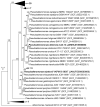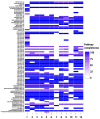Computational Insight into Intraspecies Distinctions in Pseudoalteromonas distincta: Carotenoid-like Synthesis Traits and Genomic Heterogeneity
- PMID: 36835570
- PMCID: PMC9966250
- DOI: 10.3390/ijms24044158
Computational Insight into Intraspecies Distinctions in Pseudoalteromonas distincta: Carotenoid-like Synthesis Traits and Genomic Heterogeneity
Abstract
Advances in the computational annotation of genomes and the predictive potential of current metabolic models, based on more than thousands of experimental phenotypes, allow them to be applied to identify the diversity of metabolic pathways at the level of ecophysiology differentiation within taxa and to predict phenotypes, secondary metabolites, host-associated interactions, survivability, and biochemical productivity under proposed environmental conditions. The significantly distinctive phenotypes of members of the marine bacterial species Pseudoalteromonas distincta and an inability to use common molecular markers make their identification within the genus Pseudoalteromonas and prediction of their biotechnology potential impossible without genome-scale analysis and metabolic reconstruction. A new strain, KMM 6257, of a carotenoid-like phenotype, isolated from a deep-habituating starfish, emended the description of P. distincta, particularly in the temperature growth range from 4 to 37 °C. The taxonomic status of all available closely related species was elucidated by phylogenomics. P. distincta possesses putative methylerythritol phosphate pathway II and 4,4'-diapolycopenedioate biosynthesis, related to C30 carotenoids, and their functional analogues, aryl polyene biosynthetic gene clusters (BGC). However, the yellow-orange pigmentation phenotypes in some strains coincide with the presence of a hybrid BGC encoding for aryl polyene esterified with resorcinol. The alginate degradation and glycosylated immunosuppressant production, similar to brasilicardin, streptorubin, and nucleocidines, are the common predicted features. Starch, agar, carrageenan, xylose, lignin-derived compound degradation, polysaccharide, folate, and cobalamin biosynthesis are all strain-specific.
Keywords: Pseudoalteromonas; aryl polyene hybrid; biosynthetic gene clusters; marine bacteria; metabolic pathways; metabolic reconstruction; pan-genome; phenotype variability; phylogenomic relationships.
Conflict of interest statement
The authors declare no conflict of interest.
Figures










Similar articles
-
Characterization of Pseudoalteromonas distincta-like sea-water isolates and description of Pseudoalteromonas aliena sp. nov.Int J Syst Evol Microbiol. 2004 Sep;54(Pt 5):1431-1437. doi: 10.1099/ijs.0.03053-0. Int J Syst Evol Microbiol. 2004. PMID: 15388692
-
Biosynthetic mechanism of the yellow pigments in the marine bacterium Pseudoalteromonas sp. strain T1lg65.Appl Environ Microbiol. 2024 Feb 21;90(2):e0177923. doi: 10.1128/aem.01779-23. Epub 2024 Jan 9. Appl Environ Microbiol. 2024. PMID: 38193673 Free PMC article.
-
Pseudoalteromonas translucida sp. nov. and Pseudoalteromonas paragorgicola sp. nov., and emended description of the genus.Int J Syst Evol Microbiol. 2002 Sep;52(Pt 5):1759-1766. doi: 10.1099/00207713-52-5-1759. Int J Syst Evol Microbiol. 2002. PMID: 12361284
-
Molecular Relationships in Biofilm Formation and the Biosynthesis of Exoproducts in Pseudoalteromonas spp.Mar Biotechnol (NY). 2022 Jun;24(3):431-447. doi: 10.1007/s10126-022-10097-0. Epub 2022 Apr 29. Mar Biotechnol (NY). 2022. PMID: 35486299 Review.
-
Biosynthesis and Bioactivity of Prodiginine Analogs in Marine Bacteria, Pseudoalteromonas: A Mini Review.Front Microbiol. 2019 Jul 24;10:1715. doi: 10.3389/fmicb.2019.01715. eCollection 2019. Front Microbiol. 2019. PMID: 31396200 Free PMC article. Review.
Cited by
-
Chitinolytic and Fungicidal Potential of the Marine Bacterial Strains Habituating Pacific Ocean Regions.Microorganisms. 2023 Sep 8;11(9):2255. doi: 10.3390/microorganisms11092255. Microorganisms. 2023. PMID: 37764100 Free PMC article.
-
Biotechnological Key Genes of the Rhodococcus erythropolis MGMM8 Genome: Genes for Bioremediation, Antibiotics, Plant Protection, and Growth Stimulation.Microorganisms. 2023 Dec 31;12(1):88. doi: 10.3390/microorganisms12010088. Microorganisms. 2023. PMID: 38257915 Free PMC article.
References
-
- Nedashkovkaya O.I., Kim S.-G., Balabanova L.A., Zhukova N.V., Son O.M., Tekutyeva L.A., Mikhailov V.V. Genome-based classification of strain 16-SW-7, a marine bacterium capable of converting B red blood cells, as Pseudoalteromonas distincta and proposal to reclassify Pseudoalteromonas paragorgicola as a later heterotypic synonym of Pseudoalteromonas distincta. Front. Microbiol. 2022;12:4325. doi: 10.3389/fmicb.2021.809431. - DOI - PMC - PubMed
-
- Hettle A.G., Hobbs J.K., Pluvinage B., Vickers C., Abe K.T., Salama-Alber O., McGuire B.E., Hehemann J.-H., Hui J.P.M., Berrue F., et al. Insights into the κ/ι-carrageenan metabolism pathway of some marine Pseudoalteromonas species. Commun. Biol. 2019;2:474. doi: 10.1038/s42003-019-0721-y. - DOI - PMC - PubMed
MeSH terms
Substances
Supplementary concepts
Grants and funding
LinkOut - more resources
Full Text Sources
Molecular Biology Databases
Miscellaneous

